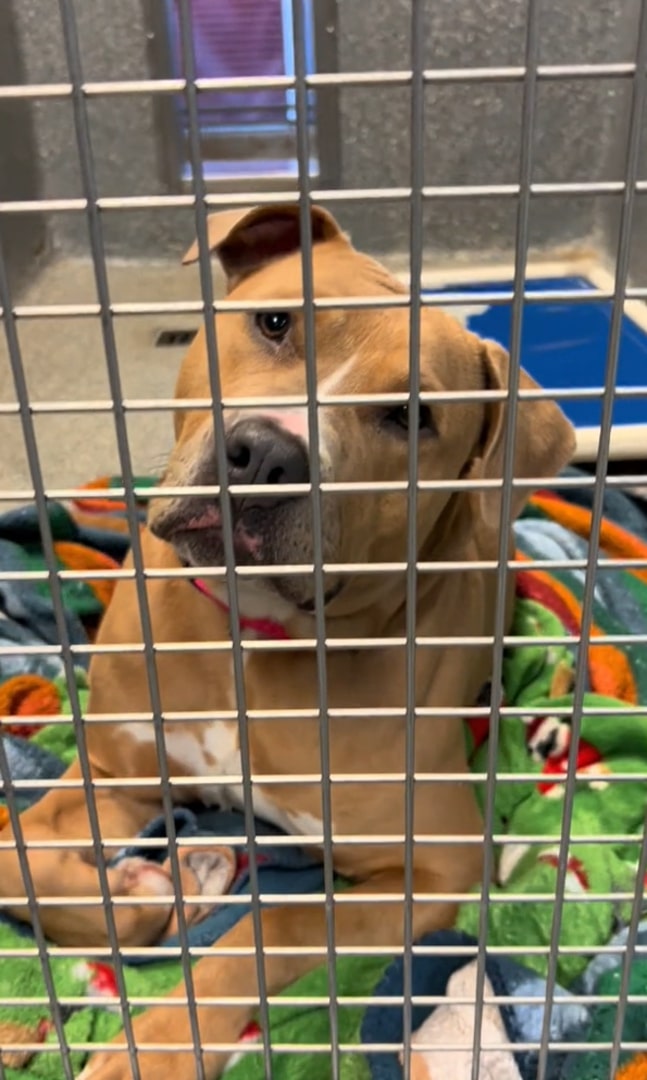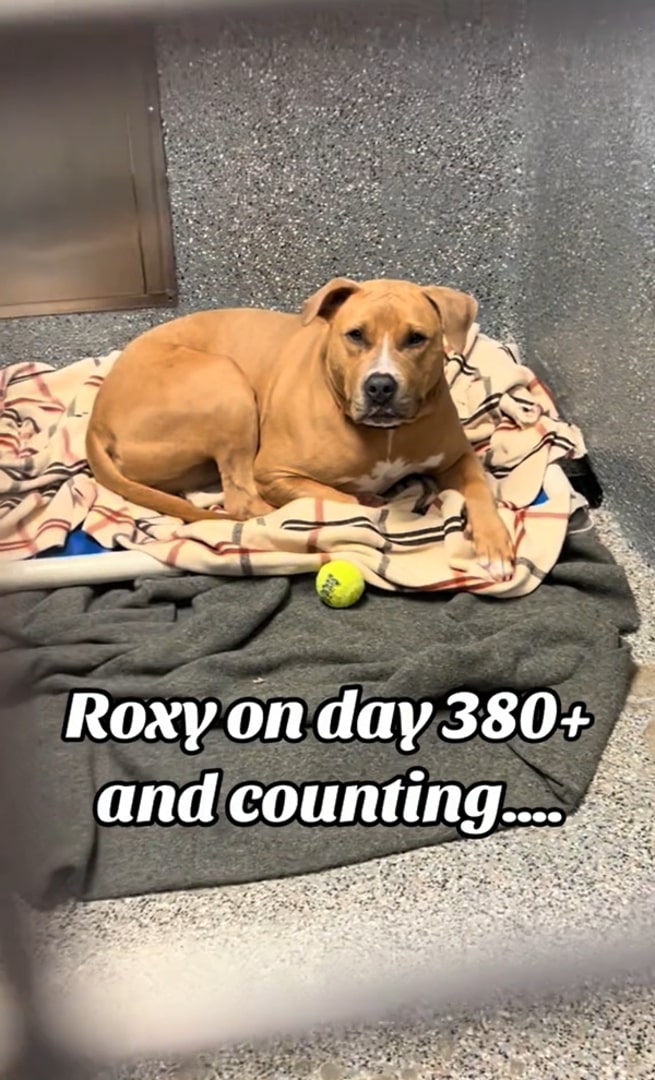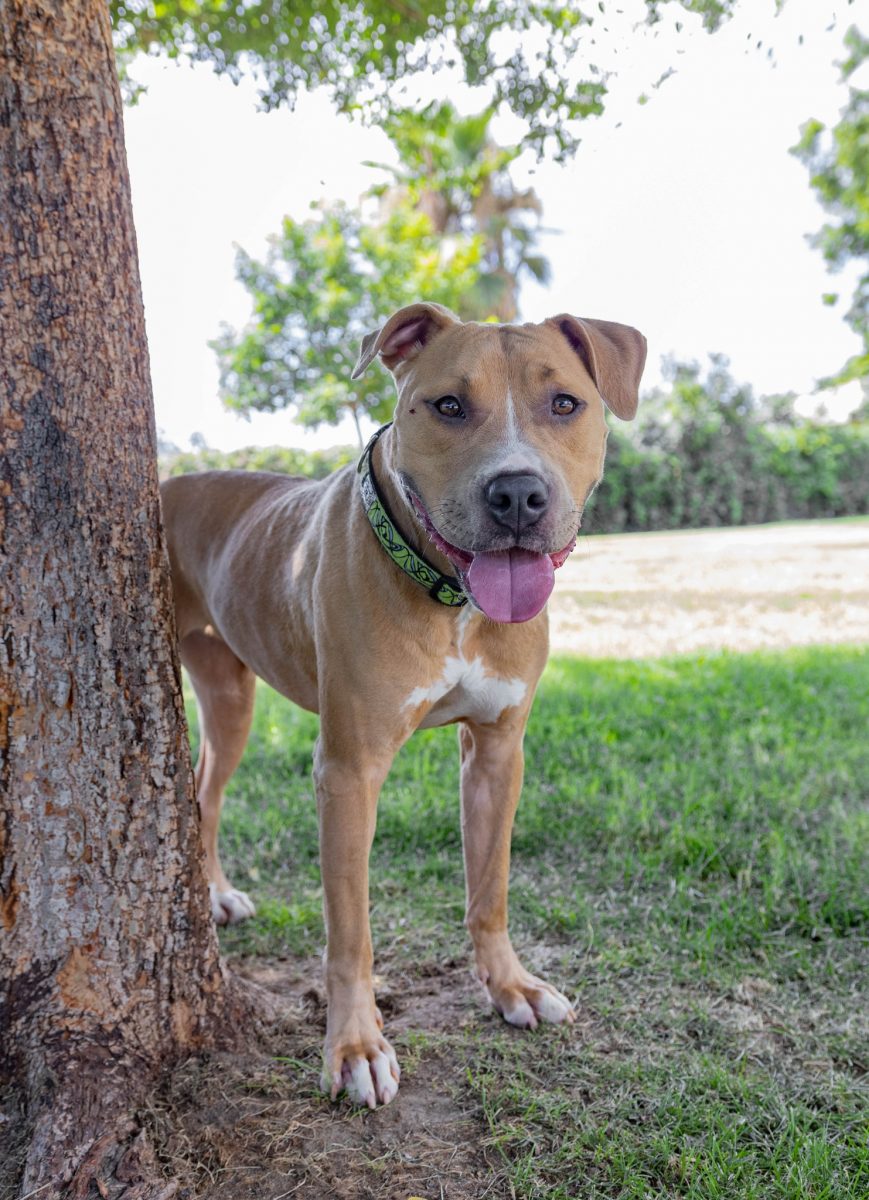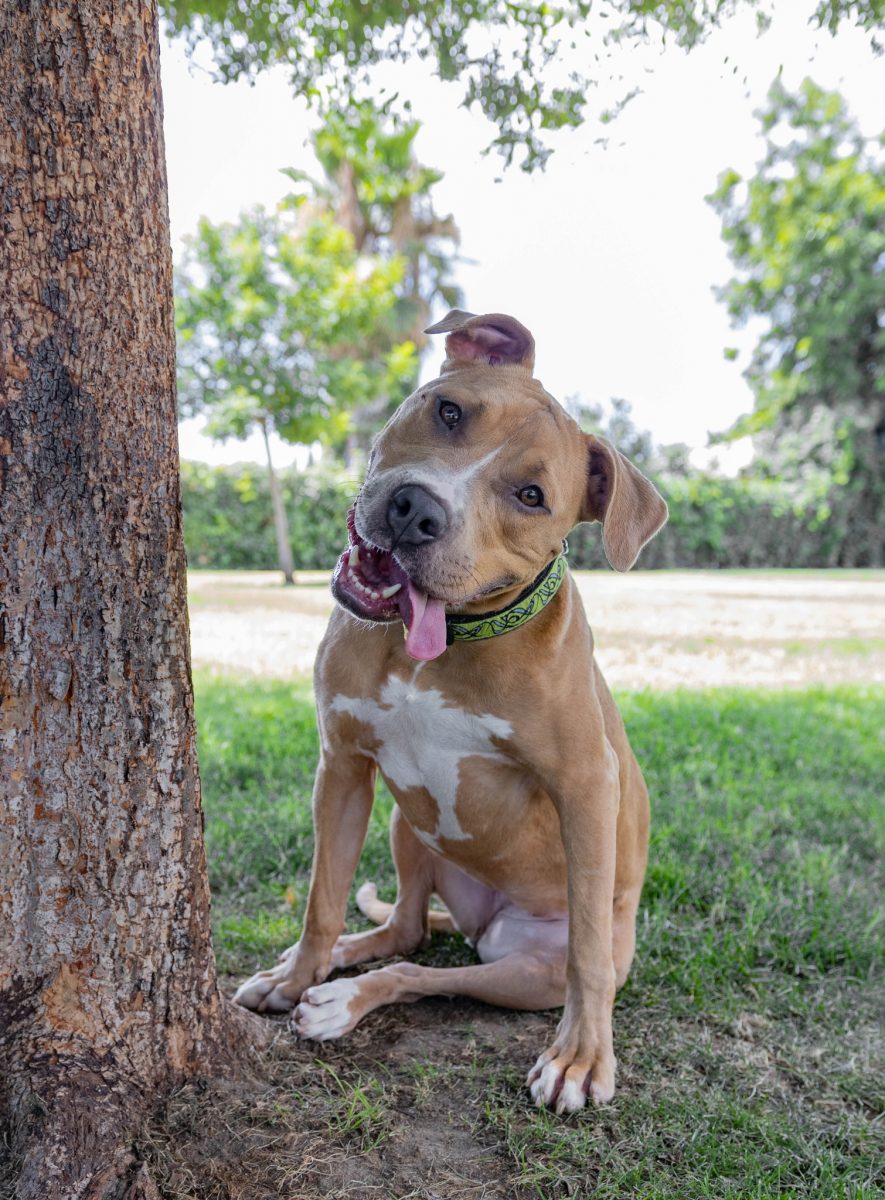Seeing a dog go to a forever home after spending its entire life in captivity is truly the greatest sight.
But, what about when you have it the other way around?
For Roxy, the sweetest Staffordshire Terrier mix, life has been everything but easy. Instead of waiting for her golden days in the warm, cosy home where she was initially adopted, this California dog had to face the harsh reality once again.
This time, sadly, Roxy spends endless days getting constantly overlooked by the people coming to adopt her shelter buddies.
Roxy’s Sad Story

Roxy knows exactly what it feels like to be a shelter dog. Before she was even adopted, she was born in Valley Animal Center, Fresno, California, alongside her seven other littermates.
Since her very puppyhood, this playful girl has been nothing but the biggest sweetheart. When the time came, she finally found her home, only to be faced with a heartbreaking turn of events.
Only a year after her adoption, Roxy was returned back to the shelter.

One of the shelter volunteers, Jackie, posted a tear-jerking video of Roxie being completely shut down behind the kennel bars. Apparently, she was returned because her owners couldn’t manage to adapt her among their livestock.
“She was adopted out from us fairly young, but unfortunately returned due to her dislike towards livestock animals,” Jackie wrote in her TikTok post.
Now, Roxie has spent more than 380 days at the shelter, waiting for the day to meet someone special – someone who wouldn’t let her go this time.
“She’s The Whole Package”

Despite her misfortune, Roxy is still holding onto hope that someone special will stumble upon her.
And, wouldn’t that be just the greatest gift ever?
For now, the shelter staff makes sure that she’s properly cared for, as this lovely girl hasn’t had it easy during the last year.
She replaced a spacious yard with a tiny kennel. And, even though the staff makes sure to take her on her regular walks – that still can’t replace the freedom she once had.

According to the shelter, Roxy is a wonderful doggo, full of energy and enthusiasm. Once she gets back on her paws, she’ll make a wonderful pet again – but her requirements are, this time, a little different.
The staff believes that Roxy would do best in a home where she’s the only pet, considering her tragic rejection the last time.
“A household with children over the age of 5 will be a great fit for her. She needs to be the only pet in the household because she does not get along well with other animals. Trust us, she is the only pet you’ll ever need. She’s the whole package, playful and loving,” the VAC team wrote on Facebook.
Once she acclimates to a new home, there’s no doubt that she’ll make the perfect fit with other animals – it is only a matter of time!
In the shelter, Roxy is already mastering her social and obedience skills. With the help of experienced dog trainers, she’s breaking all the barriers and exhibiting her amazing potential – as well as the nicest personality!
Waiting For The Pawfect Family

For now, Roxie is on the recovery path, and her team is definitely doing everything in their power to help her get there faster.
She’s still struggling in those four walls but definitely ready to embark on another exciting adventure.
“Roxy is ready for a loving family that will smother her with all the love and kisses she could ever have,” her caregivers wrote.
This time, hopefully, it’ll be forever!
Ever noticed your furry friend munching on grass like it’s the latest delicacy? It’s a common sight that often leaves pet owners puzzled. Dogs, with their quirky eating habits, sometimes leave us wondering why they have a sudden craving for greens. As a seasoned dog trainer, you’ve probably encountered this behavior more times than you can count. It’s a curious phenomenon that sparks intrigue among dog lovers worldwide.
You’ve witnessed firsthand the amusing sight of dogs grazing on grass during your training sessions. This peculiar behavior raises questions about their instincts and dietary preferences. While it may seem odd at first, there could be more to this grass-eating habit than meets the eye. As you navigate the world of canine behavior, exploring the reasons behind this behavior sheds light on the fascinating ways our four-legged companions interact with their environment.
Understanding Canine Eating Behavior
Dogs eating grass might seem strange, but it’s a common behavior among our furry friends. Here’s why they do it:
Natural Instinct
Dogs have a natural instinct to eat grass, stemming from their wild ancestors. In the wild, canines would consume plants as part of their diet for various reasons.
Digestive Aid
Grass can act as a natural laxative for dogs, helping with digestion or alleviating an upset stomach. It could be their way of self-medicating when feeling unwell.
Nutritional Deficiency
Sometimes, dogs eat grass due to a lack of certain nutrients in their diet. They might be trying to supplement their nutrition by munching on greens.
Behavioral Enrichment
Chewing on grass can also be a form of behavioral enrichment for dogs. It provides mental stimulation and helps fulfill their natural urge to explore and interact with their surroundings.
Medical Attention
While occasional grass-eating is normal, excessive consumption could be a sign of an underlying health issue. If your dog frequently eats grass and shows other unusual symptoms, it’s best to consult a veterinarian.
Understanding why dogs eat grass can shed light on their behavior and health. Keeping an eye on this habit can help you ensure your furry companion’s well-being.
Scientific Theories and Studies
Let’s take a look at some scientific insights and findings regarding why dogs eat grass:
- Instinctual Behavior
Dogs’ wild ancestors may have consumed plants as part of their diet, and this behavior could have been passed down through generations. This instinctual behavior may explain why your furry friend is drawn to grazing on grass. - Nutritional Aid
Some experts suggest that dogs may eat grass to help with their digestion. The grass can provide fiber, which aids in bowel movements, helping to regulate their digestive system. - Vitamin and Nutrient Intake
Research indicates that dogs may eat grass to supplement their diet with essential vitamins and minerals that may be lacking in their regular food. This behavior could be a way for them to fulfill their nutritional requirements. - Behavioral Enrichment
Studies have shown that dogs in enriched environments, where they have opportunities to explore and engage in natural behaviors, are less likely to exhibit destructive behaviors. Eating grass could be a form of behavioral enrichment for your pup. - Potential Health Benefits
Some studies suggest that eating grass may help dogs eliminate internal parasites or soothe an upset stomach by inducing vomiting. However, it’s essential to monitor your dog’s grass-eating habits, as excessive consumption could indicate an underlying health issue.
By understanding these scientific theories and studies, you can gain insights into your dog’s behavior and make informed decisions about their well-being. If you notice any concerning behaviors or symptoms related to grass-eating, consult with your veterinarian to ensure the health and happiness of your canine companion.
Potential Risks and Benefits
Risks
- Digestive Issues: Consuming large amounts of grass might lead to digestive problems like vomiting or diarrhea for your pup.
- Pesticide Exposure: Eating grass from treated lawns could expose your dog to harmful chemicals present in pesticides.
- Plant Toxicity: Some plants are toxic to dogs, so ingestion of certain grasses could result in poisoning and adverse effects on your canine pal.
- Dietary Fiber: Grass can provide additional fiber to aid in digestion, relieving constipation in dogs.
- Vitamin Intake: Dogs might chew on grass to supplement their diet with essential nutrients like vitamins A and C found in certain grass types.
- Natural Laxative: In some cases, grass consumption can act as a natural laxative, helping your dog pass items that are causing stomach upset.
Remember, while occasional grass-eating is normal, excessive behavior should be monitored as it could signal an underlying health issue. If you notice persistent grass consumption or abnormal behavior in your dog, it’s best to consult with your veterinarian for a proper evaluation.
Curbing Grass Eating Behavior
Managing your dog’s grass-eating habits is vital to their well-being. Here are some practical tips to help you address this behavior:
1. Dietary Evaluation
Ensure your dog’s diet is nutritionally balanced. If your pet is lacking essential nutrients, they might consume grass to compensate. Consult with your vet to adjust their diet if necessary.
2. Regular Exercise
Engage your dog in regular physical activity and mental stimulation. Boredom could lead to grass-eating as a way to pass the time. Stimulating play and exercise can reduce this behavior.
3. Supervision
Keep a close eye on your dog while they are outside. Redirect their attention if you notice them heading towards grass. Positive reinforcement when they ignore the grass can help shape their behavior.
4. Use Deterrents
Consider using pet-safe deterrent sprays on grass areas to discourage your dog from eating it. These products have safe ingredients and can help break the habit.
5. Regular Vet Check-ups
Regular visits to the vet can help identify any underlying health issues that may be causing excessive grass-eating. Your vet can provide guidance on how to address these concerns effectively.
By implementing these strategies, you can effectively curb your dog’s grass-eating behavior and ensure they maintain optimal health and well-being. Remember, monitoring your dog’s habits and seeking professional advice when needed are key to keeping your furry friend happy and healthy.
Conclusion
So, there you have it – dogs eating grass can be a mix of instinct, nutrition, and fun. It’s not always a cause for concern, but it’s good to keep an eye on it. Remember, a balanced diet, exercise, and vet visits are key. Keep your furry friend happy and healthy!
Frequently Asked Questions
Why do dogs eat grass?
Dogs might eat grass due to instinctual behavior, nutritional needs, or for behavioral enrichment.
What are the potential benefits of dogs eating grass?
Grass-eating may aid digestion, provide essential nutrients, and offer behavioral stimulation.
What are the risks of dogs eating grass?
Potential risks include digestive issues and exposure to pesticides or chemicals.
How can pet owners manage grass-eating behavior in dogs?
Ensure a balanced diet, provide regular exercise, supervise outdoor time, use deterrents, and schedule vet check-ups.
What steps can pet owners take to address excessive grass-eating in dogs?
Monitor your dog’s habits, seek veterinary advice if needed, and prioritize your dog’s health and well-being.
[no_toc]

Hey there, I’m Janet Brooks, a dog-loving student from California. I’m all about helping pups in need, especially those without homes. Me and my awesome friends work together to give shelter and love to stray dogs. Oh, and I also write blogs about dogs to share helpful info.